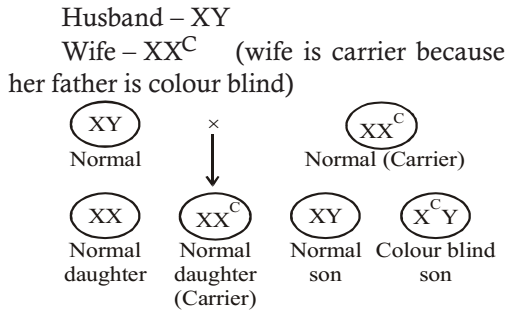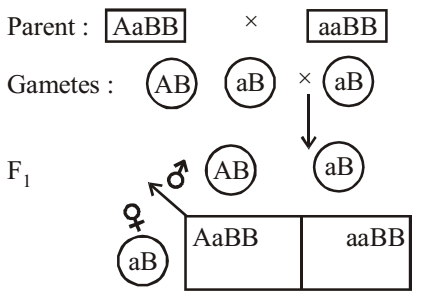Principles of Inheritance and Variation
- Diploid chromosome number in humans is
-
View Hint View Answer Discuss in Forum
Chromosomes occur in homologous pairs. Somatic cells have diploid number of chromosomes. Humans have 23 pairs i.e. 46 chromosomes. 22 pairs of autosomes and 1 pair of sex chromosomes ie. XX in females and XY in males.
Correct Option: A
Chromosomes occur in homologous pairs. Somatic cells have diploid number of chromosomes. Humans have 23 pairs i.e. 46 chromosomes. 22 pairs of autosomes and 1 pair of sex chromosomes ie. XX in females and XY in males.
- Bateson used the terms coupling and repulsion for linkage and crossing over. Name the correct parent of coupling type alongwith its cross repulsion
-
View Hint View Answer Discuss in Forum
Bateson and Punnett (1906) discovered coupling and repulsion in sweet pea (Lathyrus odoratus).
Correct Option: D
Bateson and Punnett (1906) discovered coupling and repulsion in sweet pea (Lathyrus odoratus).
- Both husband and wife have normal vision though their fathers were colour blind. The probability of their daughter becoming colour blind is
-
View Hint View Answer Discuss in Forum
The probability of the daughter becoming colour blind arises only when the father is also colour blind.

So, probability of their daughter becoming colour blind is 0%.Correct Option: A
The probability of the daughter becoming colour blind arises only when the father is also colour blind.

So, probability of their daughter becoming colour blind is 0%.
- Cross between AaBB and aaBB will form
-
View Hint View Answer Discuss in Forum
AaBB × aaBB on crossing gives 50% individuals having genotype AaBB and 50% individuals having genotype aaBB.

Correct Option: A
AaBB × aaBB on crossing gives 50% individuals having genotype AaBB and 50% individuals having genotype aaBB.

- In a genetic cross having recessive epistasis, F2 phenotypic ratio would be
-
View Hint View Answer Discuss in Forum
In recessive epistasis, the recessive alleles suppress the expression of a trait. Recessive epistasis is a type of intergenic interaction in which one non allelic gene can produce its effect independently in the dominant state but second gene can produce its effect when they are present together. Here homozygous recessive allele for a gene mask the expression of dominant allele of another gene.
Correct Option: C
In recessive epistasis, the recessive alleles suppress the expression of a trait. Recessive epistasis is a type of intergenic interaction in which one non allelic gene can produce its effect independently in the dominant state but second gene can produce its effect when they are present together. Here homozygous recessive allele for a gene mask the expression of dominant allele of another gene.

